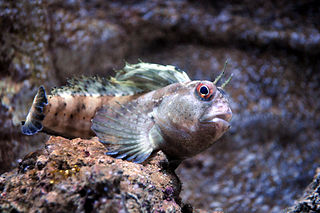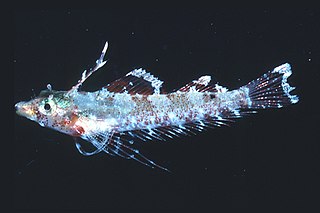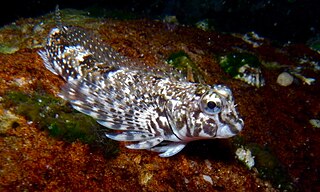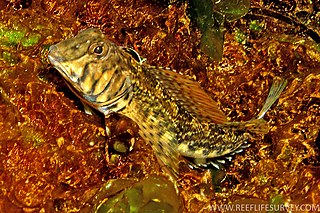
Threefin or triplefin blennies are blenniiforms, small percomorph marine fish of the family Tripterygiidae. Found in tropical and temperate waters of the Atlantic, Pacific and Indian Oceans, the family contains about 150 species in 30 genera. The family name derives from the Greek tripteros meaning "with three wings".

The tompot blenny is a species of combtooth blenny from the north eastern Atlantic Ocean which is found in shallow, coastal waters off western Europe, the Mediterranean and North Africa.

Helcogramma is a genus in the triplefin family Tripterygiidae. The blennies in the genus Helcogramma are found throughout the Indo-Pacific and in the South Atlantic Ocean off the islands of St Helena and Ascension.

The Portuguese blenny, also known as the red blenny, is a species of combtooth blenny found in the eastern Atlantic ocean off western Europe and Macaronesia.
The yellow triplefin ,> also known as the Abel's triplefin in South Africa, is a species of triplefin in the genus Enneapterygius. Males in this species can reach a maximum length of 2.5 centimetres. The blennies are generally bright yellow in colour, and males have black heads. They feed mostly on benthic invertebrates.
Enneapterygius clarkae, the barred triplefin, is a species of threefin blenny in the genus Enneapterygius. It was described by Wouter Holleman in 1982, and was given its species epithet in honour of American ichthyologist Eugenie Clark (1922-2015) It is a tropical blenny known from the Indian Ocean, and has been described from the Red Sea to Natal, South Africa. Male barred triplefins can reach a maximum length of 2.5 centimetres.

Enneapterygius elegans, the hourglass triplefin, is a species of triplefin blenny in the genus Enneapterygius. It was originally described by Wilhelm Peters as a species of Tripterygium, in 1876, but was reassigned to Enneapterygius by W. Holleman in 1986. It is a tropical blenny known from reefs across the western central Indian to the central Pacific Ocean, and swims at a depth range of 0–12 metres. Male hourglass triplefins can reach a maximum length of 4 centimetres. The blenny gets its common name from an hourglass-shaped marking on its body.
Enneapterygius elaine is a species of triplefin blenny in the genus Enneapterygius. It was described by Wouter Holleman in 2005. It is a tropical blenny known from Rodrigues Island, in the western Indian Ocean. Male Enneapterygius elaine can reach a maximum length of 2.3 centimetres. The specific name honours Elaine Heemstra of the Institute for Aquatic Biodiversity in Grahamstown who provided illustrations of reef fish for Holleman, including some in the paper in which this species was described.
Enneapterygius fasciatus, known commonly as the tiny threefin or the banded triplefin, is a species of triplefin blenny in the genus Enneapterygius. It was originally described by Weber in 1909, under the name Tripterygium fasciatum, which was later renamed Tripterygion fasciatum. It is a tropical blenny found in coral reefs in the Indian and western Pacific Oceans, and has been described from East Africa to Papua New Guinea, the Solomon Islands, and Taiwan. E. fasciatus has been recorded swimming at a depth range of 1–25 metres (3.3–82 ft). Male E. fasciatus can reach a maximum length of 3 centimetres.
Enneapterygius flavoccipitis, the yellownape triplefin or northern bicoloured triplefin, in Australia, is a species of threefin blenny in the genus Enneapterygius.
The northern yellow-black triplefin, also known as the northern Australian yellow-black triplefin, is a species of triplefin blenny in the genus Enneapterygius. It was described by German Ichthyologist Ronald Fricke in 1994. It is a tropical blenny, endemic to northern Australia, in the western Pacific and southeastern Indian Oceans. It is a non-migratory species which dwells in shallow tidal pools on coralline rock and in seagrass, and has been recorded swimming at a depth range of 0–15 m (0–50 ft). Male northern yellow-black triplefins can reach a maximum length of 2.8 centimetres.
The halfblack triplefin, also known as the half-black triplefin, blackbelly triplefin, or the green-tail threefin, is a species of triplefin blenny in the genus Enneapterygius. It was originally described by R. Kner and F. Steindachner in 1867. It is a non-migratory tropical blenny known from coral reefs in the western Pacific Ocean, and has been described from the Ryukyu Islands to eastern Australia. It has been recorded swimming at a depth range of 0–30 metres.
Enneapterygius genamaculatus is a species of triplefin blenny in the genus Enneapterygius. It was described by Wouter Holleman in 2005. This species is endemic to St Brandon shoals, part of Mauritius.
Enneapterygius altipinnis also known as the highfin triplefin is a species of triplefin blenny in the genus Enneapterygius. It is found in the Red Sea. It was regarded as a synonym of Enneapterygius tutuilae but in 2018 the species was reinstated as being valid.
Enneapterygius hollemani, or Holleman's triplefin, is a species of triplefin blenny in the genus Enneapterygius. It is found only on the central and southern coasts of Oman. It was described by John E. Randall in 1995 and was named in honour of the ichthyologist Wouter Holleman of the South African Institute for Aquatic Biodiversity.
Enneapterygius kosiensis is a species of triplefin blenny in the genus Enneapterygius. It was described by Wouter Holleman of the South African Institute for Aquatic Biodiversity in 2005. It has only been recorded from the coasts of the northern part of KwaZulu Natal in South Africa.

Enneapterygius mirabilis, the miracle triplefin, is a species of triplefin blenny in the genus Enneapterygius. It was described by Ronald Fricke in 1994 who gave it the specific name mirabilis, meaning "admirable", because its notable large pectoral fins and first dorsal fin were pretty.
Enneapterygius miyakensis, known commonly as the Izu Islands triplefin, is a species of triplefin blenny in the genus Enneapterygius. It was described by the German ichthyologist Ronald Fricke in 1987. It is only known to occur in the Izu Islands off Japan.

Lepidoblennius haplodactylus, known commonly as the eastern jumping blenny, is a species of triplefin blenny in the genus Lepidoblennius. It was described by Franz Steindachner in 1867 and is the type species of the genus Lepidoblennius.

Lepidoblennius marmoratus, known commonly as the western jumping blenny, is a species of triplefin blenny in the genus Lepidoblennius. It was first described by William John Macleay in 1878.








